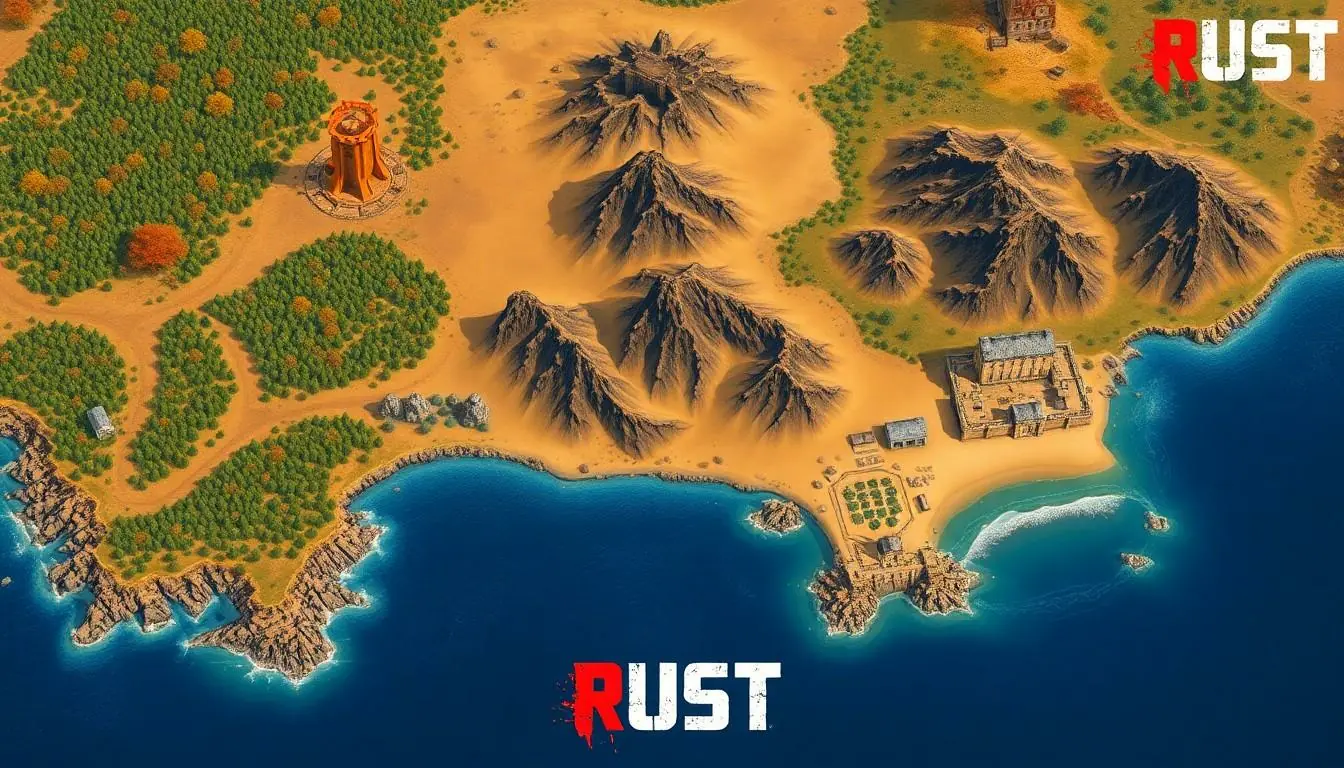In the chaotic world of Rust, survival isn’t just about crafting weapons and gathering resources; it’s about mastering the art of navigation across a vast and treacherous game map. Picture this: you’re a lone survivor, dodging bullets and wild animals, while trying not to trip over your own feet. The Rust game map is your lifeline, a sprawling landscape filled with hidden secrets and deadly foes.
Understanding its intricacies can mean the difference between life and death—or at least a very embarrassing respawn. From lush forests to barren deserts, every corner of this map has a story to tell. So buckle up and prepare to explore Rust’s unforgiving terrain, where every rock could be a potential hiding spot and every tree might just be your new best friend—or your worst enemy.
Table of Contents
ToggleOverview Of Rust Game Map
The Rust game map offers players a diverse and expansive world to explore. Featuring several distinct biomes, it includes areas like forests, deserts, mountains, and coastal shores. Each environment presents unique challenges, resources, and strategic opportunities.
Players encounter various landmarks throughout the map, such as abandoned towns, monuments, and caches. These locations often house valuable loot and serve as critical points of interest for navigation and resource gathering. Understanding these landmarks enhances a player’s ability to survive.
The layout of the Rust map is random in each wipe cycle, resulting in a different experience every time. This randomness requires players to adapt their strategies, as familiar routes may shift dramatically. Adapting to the updated terrain and resource distribution becomes essential for survival.
Risk factors vary across different zones. Areas near the center tend to be more hostile, often attracting higher player traffic. In contrast, outskirts may provide safer options for resource gathering and base building.
Environmental hazards also play a role in shaping gameplay. Players must contend with wildlife, such as bears and wolves, which can be lethal if approached carelessly. Weather conditions, like radiation storms, can challenge survival further by requiring specific preparations.
Map navigation tools enhance the player’s experience. Utilizing tools like maps or GPS provides critical information on locations and coordinates. Developing an efficient navigation strategy significantly boosts the odds of survival.
Navigating the Rust game map effectively involves continual exploration. Familiarity with terrain and local resource availability leads to better decision-making. As players traverse the landscape, remaining aware of potential threats can make the difference between life and death.
Key Features Of The Rust Game Map
Rust’s game map features intricate designs and diverse environments. Players navigate through various biomes, each presenting its unique challenges.
Landscape Diversity
Forests provide abundant resources and cover for stealthy approaches. Deserts, on the other hand, lack vegetation, making survival difficult due to scarce resources. Mountainous regions offer high vantage points but pose risks due to steep climbs. Coastal shores give access to water and a variety of marine life, which can be resource-rich. Every biome contributes to the gameplay experience, requiring players to adapt their strategies. Understanding these landscapes aids in maximizing survival chances in different conditions.
Points Of Interest
Points of interest, including abandoned towns and monuments, serve as essential navigational aids. Various landmarks host loot and resources critical for player progression. Each point presents its unique set of risks and rewards, making them essential for exploration. Monuments often contain crafting stations or valuable items but attract other players, leading to potential conflicts. Being aware of these areas enhances strategic planning and resource gathering. Utilizing these locations effectively can significantly boost a player’s chances of thriving in Rust.
Strategies For Navigating The Map
Navigating the Rust game map requires strategic planning and awareness. Players can enhance their survival chances by understanding routes and avoiding threats.
Best Routes For Resource Gathering
Abandoned towns serve as prime locations for gathering resources. Players often find high-quality loot in these areas, despite potential dangers. Coastal zones, rich in marine life, provide food sources while presenting opportunities for crafting. High-density forests offer wood and wildlife, creating ideal spots for equipment. Mountain paths can lead to hidden resources but come with higher risks. Players should prioritize routes that balance resource availability with safety.
Tips For Avoiding Encounters
Stealth plays a crucial role in avoiding player encounters. Players can utilize natural cover, such as trees or rocks, to conceal their movements. Staying aware of audio cues, like gunfire or footsteps, alerts players to nearby threats. Change direction frequently to avoid predictable patterns that can make players easy targets. Using nighttime for travel minimizes visibility to others. Opting for the outskirts of the map allows players to gather resources while limiting interactions with enemies.
The Evolution Of The Rust Game Map
The Rust game map has undergone significant transformations since its release. Each update introduces changes, correcting gameplay imbalances while enhancing player experience. Players regularly face a dynamic terrain that keeps them engaged and challenges their survival skills.
Biomes play a crucial role in shaping gameplay. Forests, deserts, mountains, and coastal regions all present distinct resource opportunities and threats. Players gather wood and food in forests, while deserts require careful management of hydration and energy.
Points of interest mark key locations on the map. Abandoned towns often contain essential supplies but attract other players, escalating tension. Meanwhile, monuments provide crafting stations and rare items, making them vital for progression.
The layout’s cyclical changes force players to adapt strategies constantly. Known paths may disappear, while new ones emerge. This fluidity pushes players to explore different areas and rethink their approaches.
Risk factors differ across zones. Central areas demand heightened awareness due to increased player activity and greater threats. Outskirts tend to offer resources with relatively lower risks, fostering safer base-building opportunities.
Environmental hazards enhance the map’s complexity. Wildlife presents both potential danger and resource, while weather conditions influence player visibility and strategies. Staying aware of these factors can significantly contribute to a player’s survival.
Utilizing navigation tools amplifies terrain awareness. Maps and GPS devices assist players in pinpointing locations of interest. Regular exploration remains fundamental in navigating Rust’s vast terrain successfully.
Conclusion
Mastering the Rust game map is crucial for survival and success. Each biome presents unique challenges and opportunities that require players to adapt their strategies. By understanding the terrain and utilizing navigation tools, players can enhance their chances of thriving in this unpredictable environment.
Exploring the diverse landscapes not only uncovers valuable resources but also sharpens survival skills. Staying aware of potential threats and leveraging the map’s dynamic nature can lead to strategic advantages. As players navigate through forests, deserts, and coastal shores, they’ll find that knowledge of the map is as essential as crafting and combat skills. Embracing exploration and adaptability will ultimately pave the way for a more rewarding experience in Rust.


